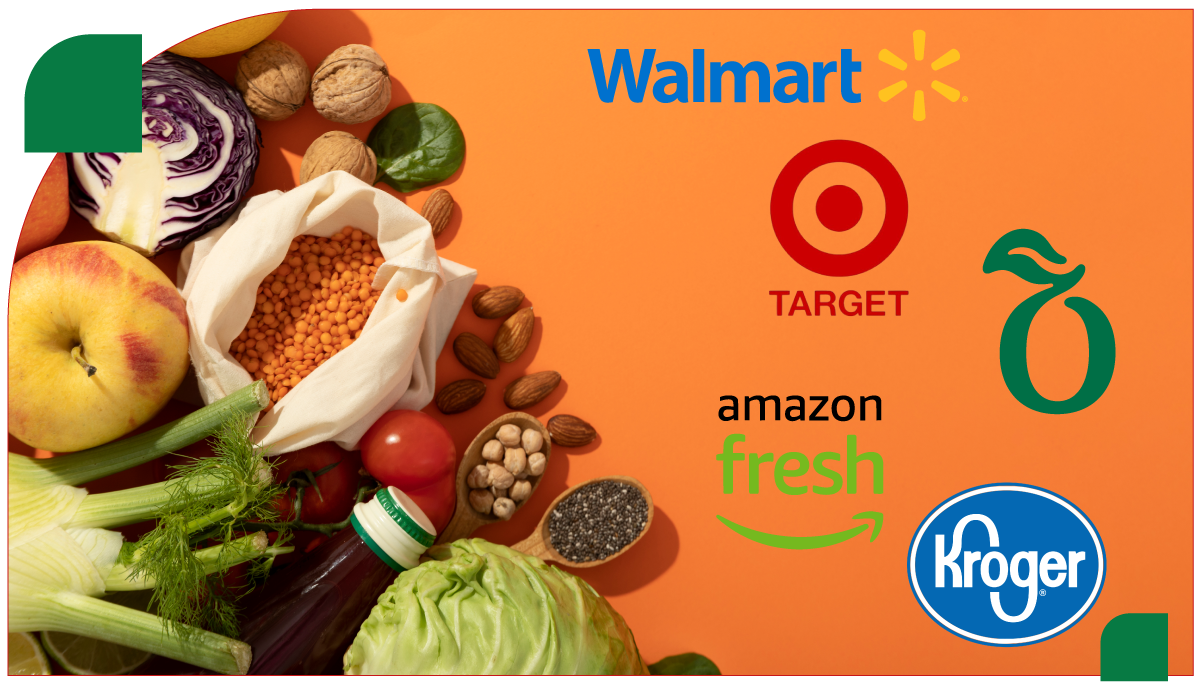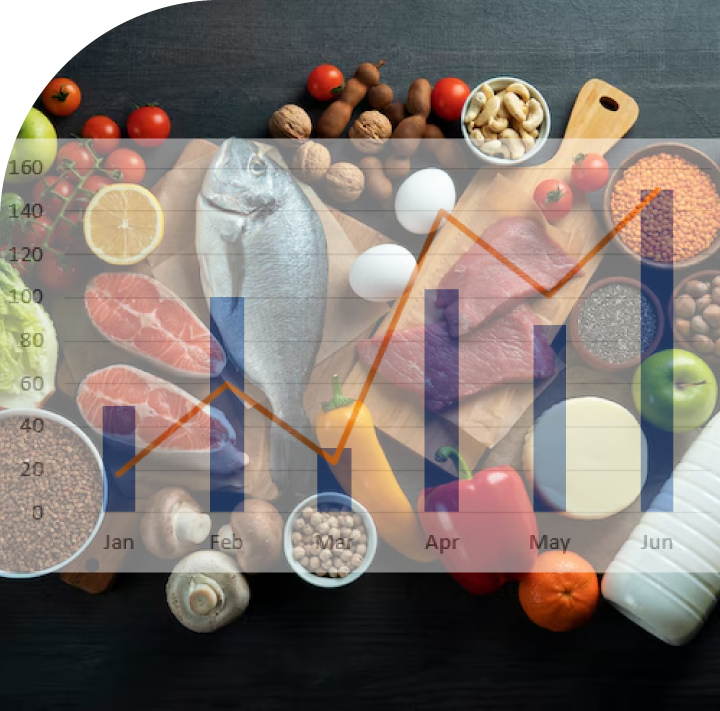Introduction
Online grocery shopping has been increasing, with almost 20% of U.S. grocery shoppers buying food online once a month or more in 2025. The COVID-19 pandemic helped drive the trend and emphasized the importance of open nutrition and ingredient labeling so people can make well-informed decisions. Physically packaged food in the U.S. comes under strict Food and Drug Administration (FDA) regulations requiring Nutrition Facts labeling, ingredient declarations, allergen notices, and percent juice labeling on some foods. These requirements have not yet been placed on online sellers, generating a regulatory loophole impacting consumer health information access. This briefing examines nutrition and ingredient information on online grocery websites, assesses approaches to Extract Nutrition and Ingredient Information from Grocery Sites, and examines health and public policy implications.
The growing need to make food nutritional information more transparent has encouraged emerging interest in Scraping Grocery Product Labels for Ingredient and Nutrition Information. While internet-based food shopping stores provide easy shopping from home, these stores have no standard methods for presenting vital data such as ingredient and nutritional facts. Therefore, consumers might not be informed enough while grocery shopping online.
Efforts to Scrape Nutrition Data from Leading Grocery Chains are necessary to bridge this gap. Using powerful scraping tools, it is now possible to extract and aggregate nutrition and ingredient data from different grocery websites. This data extraction helps consumers enjoy the same transparency as traditional stores, allowing for enhanced, informed purchase decisions.
Methodology

We analyzed 10 major U.S. online grocery retailers, representing approximately 79% of the online grocery market. These included platforms like Walmart, Target, Whole Foods, Amazon Fresh, and Kroger. A sample of 60 commonly purchased food products across eight categories (bakery, beverages, dairy, fruits and vegetables, meat, eggs, snacks, and sweets) was selected to assess the availability of four key information elements: Nutrition Facts panels, ingredient lists, allergen statements, and percent juice (for fruit drinks). Data was collected by manually reviewing product pages and using web scraping tools to extract structured information where available. In addition, we applied methods to Scrape Grocery Product Nutrition Facts and Ingredients from various grocery platforms to gather this crucial data.
We also evaluated filtering or sorting features for nutrition-related attributes. We conducted a statistical analysis to compare information availability for packaged foods (requiring FDA labeling) versus non-packaged foods (e.g., raw produce). This study highlights the need to Extract Nutrition Information from Grocery Websites and assesses whether grocery platforms meet consumer expectations for nutritional transparency. Moreover, it investigates the effectiveness of Web Scraping for Grocery Ingredients and Nutritional Data in addressing gaps in online grocery shopping experiences.
Key Findings

Availability of Nutrition and Ingredient Information
The analysis revealed significant inconsistencies in providing nutrition and ingredient information online. On average, only 35% of the 60 sampled products across the 10 retailers displayed all four required elements (Nutrition Facts, ingredients, allergens, and percent juice where applicable). Specifically:
- Nutrition Facts Panels: These are available for 45.7% of products, with the lowest availability in the meat and eggs category (24%).
- Ingredient Lists are present for 54.2% of products, with bakery items and snacks showing the lowest compliance at 30%.
- Allergen Statements: Disclosed for only 11.4% of products, posing potential safety risks for consumers with allergies.
- Percent Juice: Available for 35% of applicable fruit drink products, often buried in product descriptions rather than prominently displayed.
Subject to FDA labeling requirements, packaged foods had nutrition and ingredient information available 85% of the time, compared to just 10% for non-packaged foods like raw produce, which are exempt from such mandates. A two-sample t-test confirmed a statistically significant difference (p < 0.05) in information availability between these categories.
Technological Extraction Methods

Extracting nutrition and ingredient data from grocery websites presents both opportunities and challenges. Many platforms structure product information in HTML elements, enabling web scraping tools like BeautifulSoup or Scrapy to parse Nutrition Facts and ingredient lists. However, inconsistencies in webpage design—such as embedding data in images rather than text or using non-standardized formats—complicate automated extraction. Open Food Facts, a collaborative database, employs a combination of manual uploads and automated parsing to extract ingredient lists, achieving high accuracy for text-based data but struggling with image-based labels. Advanced techniques, such as optical character recognition (OCR) for image-based labels and natural language processing (NLP) for parsing unstructured ingredient texts, show promise but require significant computational resources and validation to ensure accuracy. To improve the accessibility and usability of this information, platforms could integrate Grocery Pricing Data Intelligence , which could provide real-time, structured data for better decision-making and more precise comparisons of product offerings.
Consumer Impact and Usability
The lack of consistent nutrition and ingredient information online undermines consumers ability to make informed dietary choices. For example, individuals managing conditions like diabetes or food allergies face heightened risks when allergen statements or sugar content are absent. While 70% of the analyzed platforms offered filtering options for nutrition-related attributes (e.g., “low sodium” or “gluten-free”), none provided sorting capabilities based on specific nutrients, limiting the usability of available data. Marketing claims, such as “all-natural” or “organic,” were more prevalent (appearing on 84% of products) than factual nutrition data, potentially misleading consumers about product healthfulness. Introducing a Grocery Price Tracking Dashboard could significantly enhance the consumer experience by allowing them to track nutritional information and pricing in real time, enabling more informed decision-making.
Table: Availability of Nutrition and Ingredient Information by Product Category
| Category |
Nutrition Facts (%) |
Ingredient List (%) |
Allergen Statement (%) |
Percent Juice (%) |
| Bakery |
40% |
30% |
29% |
N/A |
| Beverages |
50% |
60% |
15% |
35% |
| Dairy |
55% |
65% |
20% |
N/A |
| Fruits & Vegetables |
10% |
15% |
5% |
N/A |
| Meat |
24% |
30% |
10% |
N/A |
| Eggs |
24% |
25% |
8% |
N/A |
| Snacks |
45% |
30% |
29% |
N/A |
| Sweets |
50% |
35% |
29% |
N/A |
| Average |
45.7% |
54.2% |
11.4% |
35% |
Note: Percent juice applies only to beverages. Data reflects availability across 10 major U.S. online grocery retailers for 60 sampled products.
Key Analysis

Regulatory Gaps: The absence of federal mandates requiring online retailers to mirror physical packaging labels is a critical barrier to transparency. While the FDA issued a Request for Information in 2023 to explore online labeling practices, current regulations allow retailers discretion in disclosing nutrition data. This discrepancy creates an uneven playing field, where online consumers have less access to information than physical stores. The high prevalence of marketing claims over factual data further exacerbates the risk of misinformation, as consumers may prioritize unverified health assertions over verified nutritional content.
Technological Feasibility: Automated extraction tools offer a scalable solution to aggregate nutrition and ingredient data, but their effectiveness depends on standardized webpage structures. Retailers like Walmart and Whole Foods provide some structured data in JSON or HTML, facilitating scraping, but others rely on image-based labels, necessitating OCR. Collaborative platforms like Open Food Facts demonstrate the potential of crowdsourced validation combined with automation, achieving reliable ingredient extraction for 80% of text-based labels. However, scaling these solutions requires investment in machine learning models to handle diverse data formats and languages, particularly for multinational retailers. Integrating tools like a Grocery Price Dashboard could help consumers navigate large datasets, offering valuable insights into nutrition and price comparisons. Additionally, improving access to Grocery Store Datasets could facilitate the development of more robust, automated extraction systems, enhancing the accuracy and reach of online grocery data.
Public Health Implications: The limited availability of nutrition and ingredient information online disproportionately affects vulnerable populations, such as those in food deserts or with mobility limitations, who rely on online grocery shopping. The absence of allergen statements, in particular, poses immediate safety risks, while incomplete Nutrition Facts hinder long-term dietary management. Enhancing online labeling could support public health goals, such as reducing obesity and chronic diseases, by empowering consumers to select healthier options. Integrating nutrition filters and sorting tools could further align online platforms with consumer needs, mirroring in-store decision-making aids like shelf tags.
Conclusion
The current state of nutrition and ingredient information on U.S. online grocery platforms is inadequate, with only 35% of products providing comprehensive data compared to physical packaging standards. This gap undermines consumer health, particularly for those reliant on online shopping. Technological solutions, such as Grocery App Data Scraping Services , OCR, and NLP, offer promising avenues for extracting and standardizing data, but their success hinges on regulatory support and retailer cooperation. These tools can assist in automating the collection of nutrition and ingredient information, addressing the existing transparency issues.
Furthermore, methods like Web Scraping Quick Commerce Data are crucial in enhancing the speed and accuracy of data extraction, particularlyfor rapidly growing platforms with fast delivery models. Using these technologies, stakeholders can streamline the collection of vitalinformation, ensuring it is accessible to all consumers. Additionally, Grocery Delivery Scraping API Services can provide real-time,structured data that can be integrated into various platforms, supporting the goal of offering complete and reliable nutritionalinformation. By addressing these challenges, stakeholders can enhance transparency, empower consumers, and align online grocery shoppingwith public health objectives.
Are you in need of high-class scraping services? Food Data Scrape should be your first point of call. We are undoubtedly the best in Food Data Aggregator and Mobile Grocery App Scraping service and we render impeccable data insights and analytics for strategic decision-making. With a legacy of excellence as our backbone, we help companies become data-driven, fueling their development. Please take advantage of our tailored solutions that will add value to your business. Contact us today to unlock the value of your data.
























































































